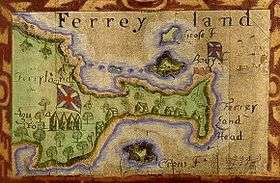Province of Avalon
| Province of Avalon | ||||||||||
| British colony | ||||||||||
| ||||||||||
|
| ||||||||||
 | ||||||||||
| Capital | Ferryland, Newfoundland | |||||||||
| Languages | English | |||||||||
| Government | Constitutional monarchy | |||||||||
| Governor | Sir George Calvert | |||||||||
| Legislature | Lords Proprietors | |||||||||
| Historical era | Colonial Era | |||||||||
| • | London and Bristol Company charter | 1610 | ||||||||
| • | Destroyed by New France in the Avalon Peninsula Campaign | 1696 | ||||||||
| Currency | Pound sterling | |||||||||
| ||||||||||
Province of Avalon was the area around the settlement of Ferryland, Newfoundland and Labrador, in the 17th century, which upon the success of the colony grew to include the land held by Sir William Vaughan and all the land that lay between Ferryland and Petty Harbour.
History
The Avalon Peninsula was one of the first European-inhabited areas in North America. In 1497 the Bristol Guild of Merchants financed a voyage by John Cabot to Newfoundland, where he is reported to have landed at Cape Bonavista.[1] Breton, Basque, and Portuguese fishermen spoke of "a land of codfish".[2] They were familiar with the Avalon Peninsula where many would set up temporary shelters to dry fish.
The London and Bristol Company
In the early 17th century English merchants began to take an interest in the Newfoundland fishery. The Bristol Society of Merchant Venturers established the London and Bristol Company (the Newfoundland Company) in 1608[3] and sent John Guy, to locate a favourable location for a colony.[4] The first permanent English settlement was established at Cuper's Cove in 1610.[5]
The company was granted a charter by James I on May 2, 1610 giving it a monopoly in agriculture, mining, fishing and hunting on the Avalon Peninsula.[6] They retained exclusive rights until 1616 when the Crown began to grant lands to others.[7]
George Calvert
Sir Sir George Calvert acquired a large land holding on the peninsula. and hired an agent Captain Edward Wynne to set up headquarters in Ferryland. The initial colony of grew to a population of 100, becoming the first successful permanent settlement on Newfoundland island. In 1620 Calvert obtained a grant from Sir William Vaughan for all of the land that lay north of a point between Fermeuse and Aquaforte to as far north as Caplin Bay (now Calvert) on the southern shore of the Avalon Peninsula.
In 1623 Calvert was given a Royal Charter extending the Royal lands and granting them the name the Province of Avalon "in imitation of Old Avalon in Somersetshire wherein Glassenbury stands, the first fruits of Christianity in Britain".[8] The charter created the province as a palatinate in which Calvert had absolute authority.Calvert wished to make the colony a refuge for Roman Catholics facing persecution in England. In 1625 Calvert was made the first Lord Baltimore.
A series of crises and calamities led Calvert to quit the colony in 1629 for "some other warmer climate of this new world", which turned out to be Maryland, though his family maintained agents to govern Avalon until 1637, when the entire island of Newfoundland was granted by charter to Sir David Kirke and James Hamilton, 1st Duke of Hamilton. Calvert's son, Cecilius Calvert, 2nd Baron Baltimore, fought against the new charter, and in 1660 gained official recognition of the old Charter of Avalon, but never attempted to retake the colony.
The site of the colony was designated a National Historic Site of Canada in 1953[9] It was also designated a Municipal Heritage District in 1998.[10]
See also
- List of communities in Newfoundland and Labrador
- Cuper's Cove
- Bristol's Hope
- British colonization of the Americas
- William Vaughan (writer)
References
- ↑ "John Day letter to the Lord Grand Admiral, Winter 1497/8", The Smugglers' City, Dept. of History, University of Bristol
- ↑ "European fishermen in Newfoundland". Retrieved 2007-09-07.
- ↑ ""Charter of the London and Bristol Company. Earl of Northhampton and Associates." Volume III 1701-1705: The Labrador Boundary Dispute Documents". Heritage.nf.ca. Retrieved 2015-03-10.
- ↑ Ross, Andrew; Smith, Andrew (2011). Canada's Entrepreneurs: From The Fur Trade to the 1929 Stock Market Crash: Portraits from the Dictionary of Canadian Biography. University of Toronto Press. ISBN 9781442662544.
- ↑ "The Cupids Colony and John Guy". Heritage Newfoundland and Labrador. Retrieved 2 November 2015.
- ↑ Naylor, R. T. (2006). Canada in the European Age, 1453-1919. McGill-Queen's Press. p. 56. ISBN 9780773575462.
- ↑ Chambers, Anne Lorene (1997). Married Women and Property Law in Victorian Ontario. University of Toronto Press. p. 34. ISBN 9780802078391.
- ↑ Kevin Major, As Near to Heaven by Sea: A History of Newfoundland and Labrador, 2001, ISBN 0-14-027864-8
- ↑ Colony of Avalon National Historic Site of Canada. Directory of Federal Heritage Designations. Parks Canada. Retrieved 8 July 2012.
- ↑ Colony of Avalon Special Preservation Area Municipal Heritage District. Canadian Register of Historic Places. Retrieved 8 July 2012.
External links
Coordinates: 47°01′21″N 52°52′45″W / 47.0226°N 52.8791°W
.svg.png)